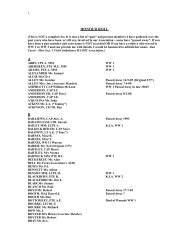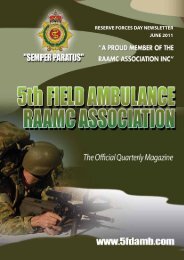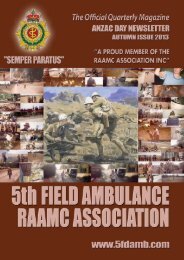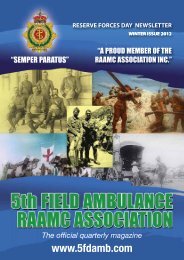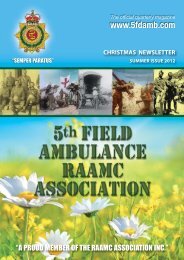2010 Paulatim Magazine - RAAMC Association
2010 Paulatim Magazine - RAAMC Association
2010 Paulatim Magazine - RAAMC Association
You also want an ePaper? Increase the reach of your titles
YUMPU automatically turns print PDFs into web optimized ePapers that Google loves.
The experience and high-end skills of <strong>RAAMC</strong> PA would make them<br />
suitable to perform many of the tasks currently reserved for MOs.<br />
Prescribing medications and performing minor procedures within the<br />
boundaries of their registration are examples. Managing resuscitations<br />
in the field as team leaders and engaging in operations in a deployed<br />
environment where the use of an MO is not considered viable are<br />
others. Such skills would make PA ideal for employment in units with a<br />
high operational tempo and the need for seasoned healthcare<br />
personnel with field experience, such as the units that make up Special<br />
Operations Command.<br />
An MPhysAsstSt would provide <strong>RAAMC</strong> medical personnel a qualification<br />
that has paramount utility in the ADF as well as a recognised<br />
professional body to ensure ongoing maintenance of a civilian<br />
qualification. Like doctors and nurses in the Army, PA will not need to<br />
undertake further studies to be able to work in their field of expertise<br />
in the community. This security may actually promote the retention of<br />
PA and the senior medics. For Medics this presents lesser risk in that<br />
staying in the Army will not be a greater risk than the potential of ‘a<br />
job waiting on the outside’. This is the converse of the situation many<br />
medics currently face, where remaining in the Army for too long carries<br />
the risk of allowing the opportunity to train for a ‘real job’ to ‘slip<br />
away’. Medics are, quite rightly, concerned about what their future<br />
employment prospects are once they commence their post-Army career.<br />
During a period of structural change, and operational manoeuvre the<br />
<strong>RAAMC</strong> should provide options to further clinical skills and professional<br />
qualifications of Military Health professionals. There is a program; there<br />
are plans for professional recognition, and a need for highly skilled<br />
healthcare personnel in the Army. Drawing on the talent from within<br />
the Corps and encouraging our most capable medics to rise to the<br />
challenge of PA is an efficient, realistic and logical way of improving<br />
retention and morale within the Corps.<br />
References<br />
By: CAPT Nevin Colgrave<br />
1. University of Queensland, Master of physician studies [Internet]. <strong>2010</strong> [cited <strong>2010</strong> May 22].<br />
Available from: http:/ /www.uq.edu.au/study/program.html?acad_prog=5474<br />
2. Frossard LA, Liebich G, Hooker RS, Brooks PM, Robinson L. Introducing physician assistants into<br />
new roles: international experiences. MJA 2008; 188(4):199-201.<br />
3. Forde A, PAhen D. Physician assistants in the military: Australian implications. JMVH <strong>2010</strong>;<br />
17(4):22-24.<br />
4. Government of South Australia. SA trials physician assistants – archived news [Internet]. 2008<br />
[cited <strong>2010</strong> May 22]. Available from:<br />
http:/ /www.adamant.com.au/our_clients/browse/www.premier.sa.gov.au/news.php?id=3601<br />
5. Queensland Government. Physician’s assistant pilot program in Queensland [Internet]. 2008<br />
[updated 2008 Oct 30; cited <strong>2010</strong> May 22]. Available from:<br />
http:/ /www.health.qld.gov.au/pa/<br />
6. Australian Army, Army School of Health. The new <strong>RAAMC</strong> training continuum and gap training<br />
[Internet]. 2009 [updated <strong>2010</strong> Feb 22; cited <strong>2010</strong> May 22]<br />
http:/ /intranet.defence.gov.au/armyweb/Sites/ASH/comweb.asp?page=194852&Title=Gap%<br />
20Training%20Info<br />
HARKNESS MEMORIAL MEDAL<br />
The award is designed as a tribute to the service given to the Corps by the late<br />
Geoffrey Harkness, OBE, ED, who served continuously in the Corps from December<br />
1941 to May 1971. Colonel Geoffrey Harkness served as an RMO in New Guinea,<br />
as a Field Ambulance Officer and as ADAH Southern Command. In addition he<br />
served for 14 years as DDGMS (CMF) AHQ. During this period he was Deputy to<br />
three DGMS' and played a significant role in the development of the Corps. He was<br />
responsible for much of the strong support the Corps has received from the civilian<br />
medical profession. His loyalty to the Corps and the DGMS', and his unselfish<br />
dedication to them was a hallmark of his service. The award is funded from a special<br />
fund raised by subscriptions from Senior Officers of the <strong>RAAMC</strong> and members of the<br />
civilian medical profession.<br />
The conditions of the selection for this award are: The emphasis is to be on<br />
contribution to the <strong>RAAMC</strong>. It is considered that this must be in every way of an<br />
outstanding nature and by which the Corps has obtained some benefit; it may be in<br />
command, administrative, clinical or technical fields. Continuous long service<br />
without any major or outstanding effort is insufficient for the purpose as the medal<br />
is not a long service award. Nominations for the award should be forwarded on<br />
an AB777 through the chain of command to reach SO2 CORPS, HLTH SVCS,<br />
Milpo BANDIANA, VIC, 3693 no later than 31 July each year.<br />
6 4 P A U L AT I M – M A GAZINE O F T HE R OYA L A U S T R A L I A N A R M Y M E DICAL C O R P S – 2 0 1 0



